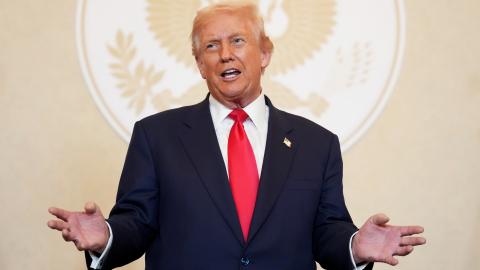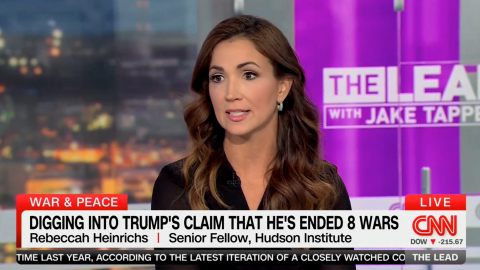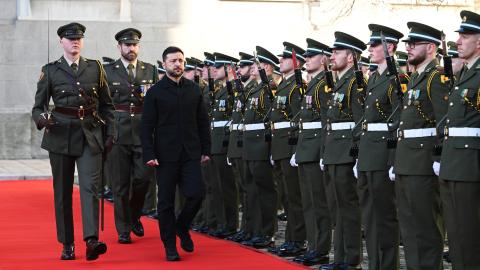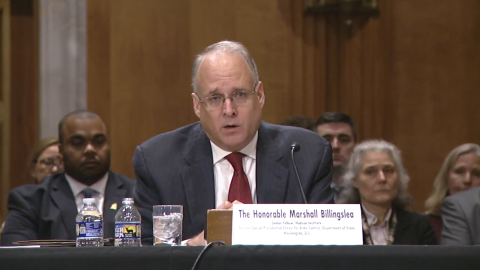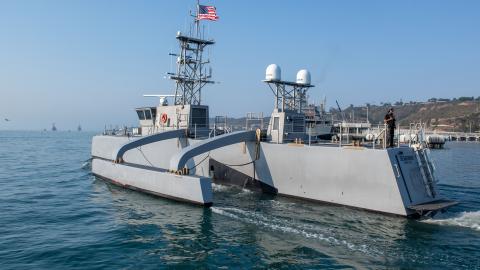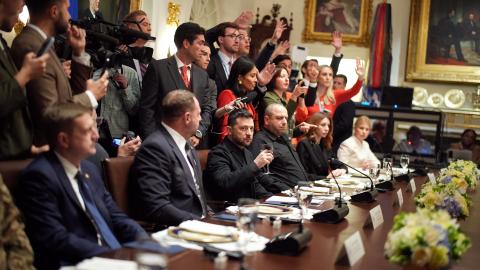President Donald Trump’s peace efforts have reached an impasse after weeks of diplomatic machinations, including meetings with Ukrainian President Volodymyr Zelenskyy and Russian President Vladimir Putin. Following President Trump’s tense meeting with Zelenskyy at the White House on October 17, the administration announced a follow-up meeting with Putin in Budapest, Hungary. But Moscow’s recent actions have derailed these talks, stalling the United States’ diplomatic efforts.
President Trump responded to Moscow’s provocations on October 22. To force Russia back to the negotiating table, he issued an executive order directing the US Treasury Department to sanction two major Russian oil companies—Rosneft and Lukoil. If fully enforced, these sanctions could be the most effective measures the US and its allies have imposed on Russia since the start of its full-scale invasion of Ukraine in February 2022.
How Supporting Ukraine Advances US National Interests
1. Protecting the US economy. North America and Europe account for nearly half of the world’s gross domestic product. Two-thirds of foreign investment into the US comes from Europe, and 46 states export more to Europe than to China. This supports millions of American jobs. European stability, which Putin’s invasion of Ukraine undermines, benefits the US economy and, by extension, the American worker. Aiding Ukraine helps preserve that stability. Moreover, Putin’s ambitions stretch beyond Ukraine, and attempting to achieve these goals would harm the US. Exemplifying his broader agenda, in recent months he has sent drones and fighter jets into European airspace and shadowed ships operating in North Atlantic Treaty Organization waters.
2. Detering Chinese aggression. Russia is China’s junior partner. A weakened or defeated Russia means a weaker China, so Beijing is watching how the West supports Ukraine. A strong and sovereign Ukraine makes Taiwan appear stronger and deters Chinese aggression. China supports Russia economically, and North Korea provides troops and missiles for Moscow’s war effort, demonstrating that European and Asian security are linked.
3. Succeeding in great power competition. Russia’s war against Ukraine is central to America’s great power competition against the Russia–China–Iran–North Korea axis. North Korea has provided more than 10,000 soldiers, millions of artillery shells, and hundreds of missiles to Russia in exchange for military technology. Meanwhile, Iran collaborates with Russia on drone production and sends Moscow ballistic missiles in exchange for fighter jets and assistance with advanced capabilities. China’s technical, economic, and diplomatic support for Russia undergirds these exchanges as part of Beijing’s strategy to undermine the US. As for China’s direct material support, it (a) purchases significant quantities of Russian oil and gas, propping up Russia’s faltering finances, and (b) transfers dual-use technologies to Russia, allowing Moscow to avoid US sanctions on crucial products like semiconductors. Russia’s below-market oil and gas sales to Beijing have also greatly strengthened Xi’s industrial economy, allowing China to build a competitive industry of refined petroleum products and basic chemicals.
4. Preparing the US military enterprise for twenty-first-century warfare. Support for Ukraine has exposed major shortcomings in the US defense industrial base that the Pentagon can now address. The war has also tested American-made military hardware in a way not possible in peacetime—with no American casualties. The US is learning what works, what does not work, and how systems evolve in combat. And as Ukraine receives US weapons, America replaces its own weapons stocks with newer, more effective systems.
5. Demonstrating strength. A successful Ukraine demonstrates American strength, political will, and unity with allies. Acquiescing to Putin and abandoning partners would signal to the world American weakness. Even forcing Ukraine into a deal that lopsidedly benefits Russia would embolden US adversaries and cause America’s allies to hedge toward other security arrangements.
A Just Peace for Ukraine
Ideally, the US and its allies would provide Ukraine with the necessary financial and military resources to expel the Russian invaders from its internationally recognized territory. Unfortunately, this is not going to happen. The best realistic outcome is a fair and just peace for Ukraine that prevents future Russian aggression.
A just and fair peace is also in President Trump’s political interests. Any outcome that suggests Russia won in Ukraine would severely damage his international credibility as a statesman. It would also hurt his popularity at home, as the vast majority of Americans, including Republicans, do not trust Putin. If the Kremlin emerges from the war having achieved a meaningful part of its territorial and political ambitions, President Trump’s critics at home and abroad will rightly question his foreign policy acumen—and American resolve.
Ukrainians want the war to end, but they do not want to surrender. President Trump should push for a just peace rooted in four essential principles:
- Formal nonrecognition of Russian-occupied Ukrainian territory. The United States should never legitimize Russian-occupied areas of Ukraine as part of the Russian Federation. The 1940 Welles Declaration, wherein the US refused to recognize Soviet control of the Baltic states during the Cold War, is a useful precedent for how such a policy can uphold international law.
- Full preservation of Ukrainian sovereignty. Ukraine needs the right to shape its government, conduct elections, join alliances, and build its military free from Russian interference.
- Meaningful reconstruction assistance. Western governments and institutions should help fund Ukraine’s recovery with a combination of frozen Russian assets, private investment, and direct aid, ensuring the country’s economic resilience and long-term stability.
- The return of prisoners of war, political detainees, and abducted Ukrainian children. Tens of thousands of Ukrainians remain in Russian custody, including thousands of children forcibly taken from their families. For moral and legal reasons, Ukraine and its partners should prioritize repatriation in settlement talks.
Real Pressure Is Needed
The recent sanctions on Rosneft and Lukoil are a good step. But the Trump administration will have to do more if it hopes to get Putin to the negotiating table in good faith. The US needs a comprehensive strategy that demonstrates American strength, resolve, and commitment to ending the war honorably and on just terms. To apply real pressure on the Kremlin, Washington should:
- Demonstrate US leadership with a presidential visit to Kyiv—via Boryspil International Airport. The meeting in Budapest may have been scrapped. But the White House should not allow its diplomatic momentum to stall. A presidential visit to Ukraine would demonstrate American resolve, reassure allies, and send an unmistakable signal to Moscow that the United States president can go wherever he wants, whenever he wants, however he wants. To underscore this message, President Trump could land at Boryspil International Airport outside Kyiv, which has remained closed since the war started on February 24, 2022. Such a show of confidence and strength would underscore US leadership on the world stage and remind both friends and foes that President Trump sets the tempo for diplomacy and peace.
- Aggressively enforce secondary sanctions on Lukoil and Rosneft. Announcing the sanctions was an important step. But real pressure will come from forcing foreign banks, insurers, and trading firms to choose between participation in Russia’s oil sector and participation in the US-led global financial system. To reinforce the credibility of US sanctions and deter future violations, Washington should (a) aggressively target banks and refineries that continue purchasing or financing exports linked to Rosneft or Lukoil and (b) publicize which institutions are cut off from their accounts for facilitating shadow shipments or illicit financial transfers.
- Close sanctions loopholes. Russia diverts much of its trade through a network of partner countries to evade Western sanctions. To more effectively weaken the Russian economy, Washington should:
- Rigorously enforce sanctions on Russian oil sales, including strict prohibitions on Russia’s shadow fleet—particularly in Mediterranean waters, where a large share of ship-to-ship transfers of sanctioned cargo take place.
- Sanction banks in China, India, Cyprus, and Hong Kong that facilitate Russian oil transactions or the acquisition of sanctioned technologies.
- Collaborate with European allies to use Russian assets frozen in Belgium as collateral for loans to Ukraine.
- Sanction Russian banks and oligarchs, as well as foreign financial institutions that purchase Russian sovereign bonds. Russia lacks the reserves and borrowing capacity to offset these measures, which would materially undermine its ability to finance the war while maintaining social spending and controlling inflation.
- Leverage open-source intelligence (OSINT) to crack down on Russia’s and Iran’s global sanctions-evasion supply chains. The administration should initiate a trilateral intelligence mechanism that includes Ukraine’s Main Directorate of Intelligence (GUR), the US Defense Intelligence Agency (DIA), and NATO to disrupt Russian and Iranian illicit supply chains. This mechanism would leverage the DIA’s cutting-edge OSINT expertise, the GUR’s on-the-ground experience, and NATO’s international sway to produce public products that expose shell companies, false end-user manifests, and flows of Western dual-use components into Russia and Iran. This effort should include a vetted crowdsourcing platform that allows think tanks, private intel firms, and other OSINT practitioners to share their findings.
- Promote a pro-America energy policy. Congress and the executive branch should remove burdensome regulatory hurdles and statutory requirements that might restrict the production and export of liquefied natural gas (LNG) and crude oil. Looking internationally, the White House needs to identify key importers of Russian energy and support their transition to US or allied suppliers. Expanding US oil and gas production—and encouraging oil-rich partners like the Gulf states to do so as well—would lower global energy prices and weaken one of Russia’s primary economic lifelines. President Ronald Reagan engineered record-low oil prices in the 1980s by spurring US and Gulf production. This played an important role in bankrupting the Soviet Union.
- Sign an agreement to integrate Ukraine’s defense sector with America’s. Ukraine has a skilled, innovative, and educated defense industrial workforce. Before 2014 the country ranked among the world’s top 10 defense exporters. And even while at war, it has fielded groundbreaking systems, especially in the unmanned sector. Strengthening Ukraine’s indigenous defense industry and integrating it with US production, research and development, and supply chains would allow Washington to advance its own defense industry and help guarantee Ukraine’s long-term security.
- Remove restrictions on the use of US-provided weapons and encourage European partners to do the same. By observing Moscow’s spurious red lines, Washington cedes the initiative to the Kremlin. The United States should permit Ukraine to employ any US-supplied system against legitimate military targets—including targets deep inside Russian territory that are directly linked to attacks on Ukraine. The US should coordinate with allies on rules of engagement, provide enhanced target-identification support, and maintain robust end-use monitoring to minimize civilian harm and manage escalation. Clear public communication and intensified military penalties for further Russian aggression would maximize deterrence.
- Rapidly expand calibrated long-range strike support to degrade Russia’s defense industrial base. The Tomahawk cruise missile is a powerful option for striking critical production and logistics nodes deep inside Russia. It can be fired from mobile launchers such as Typhon or comparable systems. If the US provides Ukraine with these missiles and assists with robust target acquisition and battle damage assessment, it could greatly enhance Kyiv’s long-range strike capability. Priority targets include drone and missile production facilities like the Shahed production site in Tatarstan and missile manufacturing plants such as those in Votkinsk.
- Support Ukraine’s indigenous strike programs and allow it to sustain its high-tempo attacks on Russian energy and military facilities. High-tempo attacks on Russian energy infrastructure can rapidly erode Moscow’s war economy. The US should provide comprehensive technical, logistical, and intelligence support for Ukraine’s domestic strike systems (like the Flamingo cruise missile and FP-1 drone) to enable Kyiv to launch sustained long-range salvos. Continued pressure would strain Russia’s finances and industry and strengthen Ukraine’s diplomatic leverage.
- Expand NATO’s Prioritized Ukraine Requirements List (PURL). The PURL has emerged as an effective burden-sharing mechanism, aggregating more than $2 billion in funding from European nations and fielding packages worth hundreds of millions of dollars. Currently, each PURL package is worth $500 million. Washington should support larger tranches in the billion-dollar range that explicitly include long-range munitions and launchers; intelligence, surveillance, and reconnaissance (ISR) capabilities; and investments to strengthen Ukraine’s defense industrial base. Washington and its partners should also pair these larger tranches with coordinated procurement, accelerated export authorizations, pooled financing or loan guarantees (where appropriate), and an industrial partnership plan to scale Ukrainian production and integrate allied supply chains.
The Kremlin has stalled negotiations because Putin still believes he can improve his position and extract greater concessions from Ukraine and the West. By ramping up support for Ukraine at this critical juncture, the Trump administration can weaken Putin’s hand and force him to negotiate on terms more favorable to Ukraine and its partners, including the United States.
